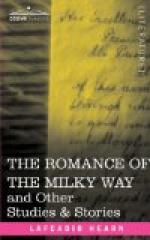[Footnote 2: This is the Japanese reading of the Chinese name.]
* * * * *
—It is said that the meeting of the Herdsman and the Weaver can be observed by any one with good eyes; for whenever it occurs those stars burn with five different colors. That is why offerings of five colors are made to the Tanabata divinities, and why the poems composed in their praise are written upon paper of five different tints.
But, as I have said before, the pair can meet only in fair weather. If there be the least rain upon the seventh night, the River of Heaven will rise, and the lovers must wait another whole year. Therefore the rain that happens to fall on Tanabata night is called Namida no Am[’e], “The Rain of Tears.”
When the sky is clear on the seventh night, the lovers are fortunate; and their stars can be seen to sparkle with delight. If the star Kengy[=u] then shines very brightly, there will be great rice crops in the autumn. If the star Shokujo looks brighter than usual, there will be a prosperous time for weavers, and for every kind of female industry.
* * * * *
In old Japan it was generally supposed that the meeting of the pair signified good fortune to mortals. Even to-day, in many parts of the country, children sing a little song on the evening of the Tanabata festival,—Tenki ni nari! ("O weather, be clear!”) In the province of Iga the young folks also sing a jesting song at the supposed hour of the lovers’ meeting:—
Tanabata ya!
Amari isogaba,
Korobub[’e]shi![3]
But in the province of Izumo, which is a very rainy district, the contrary belief prevails; and it is thought that if the sky be clear on the seventh day of the seventh month, misfortune will follow. The local explanation of this belief is that if the stars can meet, there will be born from their union many evil deities who will afflict the country with drought and other calamities.
[Footnote 3: “Ho! Tanabata! if you hurry too much, you will tumble down!”]
* * * * *
The festival of Tanabata was first celebrated in Japan on the seventh day of the seventh month of Tomby[=o] Sh[=o]h[=o] (A.D. 755). Perhaps the Chinese origin of the Tanabata divinities accounts for the fact that their public worship was at no time represented by many temples.
I have been able to find record of only one temple to them, called Tanabata-jinja, which was situated at a village called Hoshiaimura, in the province of Owari, and surrounded by a grove called Tanabata-mori.[4]
[Footnote 4: There is no mention, however, of any such village in any modern directory.]
Even before Temby[=o] Sh[=o]h[=o], however, the legend of the Weaving-Maiden seems to have been well known in Japan; for it is recorded that on the seventh night of the seventh year of Y[=o]r[=o] (A.D. 723) the poet Yamagami no Okura composed the song:—




